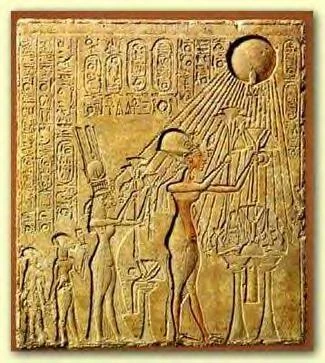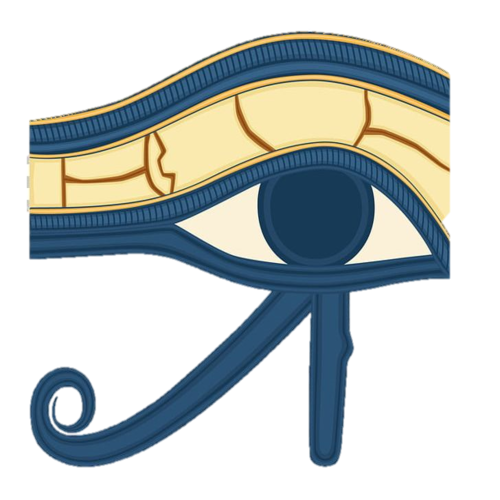| Aten | |||||
|---|---|---|---|---|---|
| |||||
| Period of worship |
18th Dynasty | ||||
| Cult center | Amarna | ||||
| Symbol(s) | Sun disc | ||||
| Association | Sun, creation, kingship | ||||
| Appearance | Sun disc, sun rays | ||||
Aten is the creator of the universe in ancient Egyptian Mythology, usually regarded as a sun god represented by the sun's disk. His worship (Atenism) was instituted as the basis for the mostly monotheistic — in fact, monistic — religion of Amenhotep IV, who took the name Akhenaten. The worship of Aten seems to have ceased shortly after Akhenaten's death.
History[]
During the early stages of the New Kingdom the priesthood of the Theban god Amun rapidly rose in power as earlier kings payed massive tribute to the god by expanding his temple complex at Karnak. Unlike his dynastic predecessors, Thutmose IV's reign marked an increase in royal importance of the sun cult at Heliopolis and Giza.[1] The influence of Heliopolis on Thutmose IV becomes the clearest by his personal identification with the sun god; for the first time we see the living pharaoh depicted with the sun disc on his head, symbolic for the sun god.[1] The Aten also first appears as an independent deity during his reign.[1] His successor, Amenhotep III, associated himself with the Aten as well. During the reign of Akhenaten the Aten suddenly rose to absolute supremacy.
Overview[]

Pharaoh Akhenaten and his family adoring the Aten
Aten was the focus of Akhenaten's religion, but viewing Aten as Akhenaten's god is a simplification. Aten is the name given to represent the solar disc. The term Aten was used to designate a disc, and since the sun was a disc, gradually became associated with solar deities. Aten expresses indirectly the life-giving force of light. The full title of Akhenaten's god was The Rahorus who rejoices in the horizon, in his/her Name of the Light which is seen in the sun disc. (This is the title of the god as it appears on the numerous stelae which were placed to mark the boundaries of Akhenaten's new capital at Amarna, or "Akhetaten.") This lengthy name was often shortened to Ra-Horus-Aten or just Aten in many texts, but the god Akhenaten had raised to supremacy is considered a synthesis of very ancient ones viewed in a new and different way. Both Ra and Horus characteristics are part of the god, but the god is also considered to be both masculine and feminine simultaneously. All creation was thought to emanate from the god and to exist within the god. In particular, the god was not depicted in anthropomorphic (human) form, but as rays of light extending from the sun's disk. Furthermore, the god's name came to be written within a cartouche, along with the titles normally given to a Pharaoh, another break with ancient tradition.
The Aten first appears in texts dating to the 12th Dynasty, in The Story of Sinuhe. Ra-Horus, more usually referred to as Ra-Herakhty (Ra, who is Horus of the two horizons), is a synthesis of two other gods, both of which are attested from very early on. During the Amarna period, this synthesis was seen as the invisible source of energy of the sun god, of which the visible manifestation was the Aten, the solar disk. Thus Ra-Horus-Aten was a development of old ideas which came gradually. The real change is the apparent abandonment of all other gods following the advent of Akhenaten, i.e., the introduction, apparently by Akhenaten, of monotheism. This is readily apparent in the Great Hymn to the Aten.
Royal Titulary[]
During the Amarna Period, the Aten was given a Royal Titulary (as he was considered to be king of all), with his names drawn in a cartouche. There were 2 forms of this title, the first had the names of other gods, and the second later one which was more 'singular' and referred only to the Aten himself.
Early form[]
Live Re-Horakhti who rejoices in the Horizon
In his name Shu which is the Aten
Later form[]
Live Re, ruler of the 2 horizons who rejoices in the Horizon
In his name of light which is the Aten
Variant Vocalizations[]
Egyptologists have also vocalized the name as Aton, Atonu, Itni, Itn, and Adon (possibly the source of one of the Hebrew God's names, Adon).
Variant Translations[]
Because high relief and low relief illustrations of the Aten show it with a curved surface (see for example the photograph illustrating this article), the late scholar Hugh Nibley insisted that a more correct translation would be globe, orb or sphere, rather than disk.
The three-dimensional spherical shape of the Aten is even more evident when such reliefs are viewed in person, rather than merely in photographs.
References[]
Bibliography[]
- Collier, Mark and Manley, Bill. How to Read Egyptian Hieroglyphs: Revised Edition. Berkeley: University of California Press, 1998.
- Reeves, N., 2001: Akhenaten, Egypt's False Prophet. Thames & Hudson, London.

